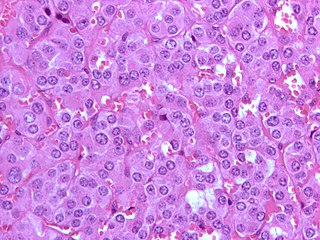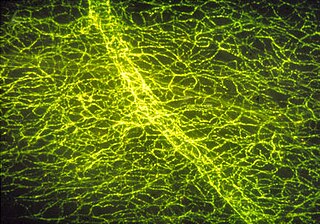
A catecholamine is a monoamine neurotransmitter, an organic compound that has a catechol and a side-chain amine.

The sympathetic nervous system (SNS) is one of the two main divisions of the autonomic nervous system, the other being the parasympathetic nervous system.

The adrenergic receptors or adrenoceptors are a class of G protein-coupled receptors that are targets of many catecholamines like norepinephrine (noradrenaline) and epinephrine (adrenaline) produced by the body, but also many medications like beta blockers, β2 agonists and α2 agonists, which are used to treat high blood pressure and asthma for example.

Pheochromocytoma (PCC) is a neuroendocrine tumor of the medulla of the adrenal glands, or extra-adrenal chromaffin tissue that failed to involute after birth, that secretes high amounts of catecholamines, mostly norepinephrine, plus epinephrine to a lesser extent. Extra-adrenal paragangliomas are closely related, though less common, tumors that originate in the ganglia of the sympathetic nervous system and are named based upon the primary anatomical site of origin. The term is from the Greek phaios (dark), chroma (color), kytos (cell), and -oma (tumor).

Chromaffin cells, also pheochromocytes, are neuroendocrine cells found mostly in the medulla of the adrenal glands in mammals. These cells serve a variety of functions such as serving as a response to stress, monitoring carbon dioxide and oxygen concentrations in the body, maintenance of respiration and the regulation of blood pressure. They are in close proximity to pre-synaptic sympathetic ganglia of the sympathetic nervous system, with which they communicate, and structurally they are similar to post-synaptic sympathetic neurons. In order to activate chromaffin cells, the splanchnic nerve of the sympathetic nervous system releases acetylcholine, which then binds to nicotinic acetylcholine receptors on the adrenal medulla. This causes the release of catecholamines. The chromaffin cells release catecholamines: ~80% of adrenaline (epinephrine) and ~20% of noradrenaline (norepinephrine) into systemic circulation for systemic effects on multiple organs, and can also send paracrine signals. Hence they are called neuroendocrine cells.

Sympathomimetic drugs are stimulant compounds which mimic the effects of endogenous agonists of the sympathetic nervous system. The primary endogenous agonists of the sympathetic nervous system are the catecholamines, which function as both neurotransmitters and hormones. Sympathomimetic drugs are used to treat cardiac arrest and low blood pressure, or even delay premature labor, among other things.
An adrenergic agonist is a drug that stimulates a response from the adrenergic receptors. The five main categories of adrenergic receptors are: α1, α2, β1, β2, and β3, although there are more subtypes, and agonists vary in specificity between these receptors, and may be classified respectively. However, there are also other mechanisms of adrenergic agonism. Epinephrine and norepinephrine are endogenous and broad-spectrum. More selective agonists are more useful in pharmacology.

In the autonomic nervous system, fibers from the ganglion to the effector organ are called postganglionic fibers.

The celiac ganglia or coeliac ganglia are two large irregularly shaped masses of nerve tissue in the upper abdomen. Part of the sympathetic subdivision of the autonomic nervous system (ANS), the two celiac ganglia are the largest ganglia in the ANS, and they innervate most of the digestive tract.
The alpha-1 (α1) adrenergic receptor is a G protein-coupled receptor (GPCR) associated with the Gq heterotrimeric G-protein. It consists of three highly homologous subtypes, including α1A-, α1B-, and α1D-adrenergic. Catecholamines like norepinephrine (noradrenaline) and epinephrine (adrenaline) signal through the α1-adrenergic receptor in the central and peripheral nervous systems. There is no α1C receptor. At one time, there was a subtype known as α1C, but it was found to be identical to the previously discovered α1A receptor subtype. To avoid confusion, naming was continued with the letter D.

Adrenaline, also known as adrenalin or epinephrine, is a hormone, neurotransmitter, and medication. Epinephrine is normally produced by both the adrenal glands and certain neurons. It plays an important role in the fight-or-flight response by increasing blood flow to muscles, output of the heart, pupil dilation response, and blood sugar level. It does this by binding to alpha and beta receptors. It is found in many animals and some single cell organisms. Napoleon Cybulski first isolated epinephrine in 1895.
An adrenergic storm is a sudden and dramatic increase in serum levels of the catecholamines adrenaline and noradrenaline, with a less significant increase in dopamine transmission. It is a life-threatening condition because of extreme tachycardia and hypertension, and is especially dire for those with prior heart problems. If treatment is prompt, prognosis is good; typically large amounts of diazepam or other benzodiazepines are administered alongside beta blockers. Beta blockers are contraindicated in some patients, so other anti-hypertensive medication such as clonidine may be used. It is usually caused by overdose of stimulants, especially cocaine or methamphetamine, or eating foods high in tyramine while taking monoamine oxidase inhibitors. A subarachnoid hemorrhage can also cause an adrenergic storm. A catecholamine storm is part of the normal course of Rabies infection, and is responsible for the severe feelings of agitation, terror, and dysautonomia present in the pre-coma stage of the disease.
Catecholaminergic means "related to catecholamines". The catecholamine neurotransmitters include dopamine, epinephrine (adrenaline), and norepinephrine (noradrenaline).
Adrenergic cell group C1 is a group of cells that show evidence of phenylethanolamine N-methyltransferase (PNMT), the enzyme that converts norepinephrine to epinephrine (adrenalin); thus, they are regarded as 'putative adrenergic cells'. They are found in the ventrolateral medulla in conjunction with the noradrenergic cell group A1. The adrenergic group C1 is seen in vertebrates, including rodents and primates.
Adrenergic cell group C2 is a group of cells that label for PNMT, the enzyme that converts norepinephrine to epinephrine (adrenalin); thus, they are regarded as 'putative adrenergic cells'. They are found in the dorsomedial medulla in conjunction with the noradrenergic cell group A2. They are seen in vertebrates, including rodents and primates.
Catecholaminergic cell groups refers to collections of neurons in the central nervous system that have been demonstrated by histochemical fluorescence to contain one of the neurotransmitters dopamine or norepinephrine. Thus, it represents the combination of dopaminergic cell groups and noradrenergic cell groups. Some authors include in this category 'putative' adrenergic cell groups, collections of neurons that stain for PNMT, the enzyme that converts norepinephrine to epinephrine (adrenalin).
Noradrenergic cell groups refers to collections of neurons in the central nervous system that have been demonstrated by histochemical fluorescence to contain the neurotransmitter norepinephrine (noradrenalin). They are named

The catecholamines comprise the endogenous substances dopamine, noradrenaline (norepinephrine) and adrenaline (epinephrine) as well as numerous artificially synthesized compounds such as isoprenaline. Their investigation constitutes a prominent chapter in the history of physiology, biochemistry and pharmacology. Adrenaline was the first hormone extracted from its endocrine gland and obtained in pure form, before the word hormone was coined. It was also the first hormone the structure and biosynthesis of which were clarified. Apart from acetylcholine, adrenaline and noradrenaline were the first neurotransmitters to be discovered and the first intercellular biochemical signals to be found in intracellular vesicles. The β-adrenoceptor was the first G protein-coupled receptor the gene of which was cloned.










